originally posted at https://canmom.tumblr.com/post/180346...
contains spoilers for: Tokyo Ghoul (the first season of the anime only), NieR, NieR: Automata, Mononoke-hime
(related: Violence and ‘evil races’, the NieR story)
I watched the first season of the anime Tokyo Ghoul, in part because I know one or two friends who like it, and in part because I heard it came up in connection with Yoko Taro in some way as an inspiration for some part of the NieR series - although now I go to confirm it, it seems like the only connection is that 9S and the protagonist of TG (snrk) are voiced by the same actor, and Yoko Taro had never watched TG until he got around to casting 9S and Yosuke Saito suggested it… so I guess I just completely made that up?
Regardless…
TG is pretty silly and hard to take seriously most of the time. It feels like a shonen anime but drenched in gratuitous blood and cannibalism. Still I think there’s some interesting things there, and I feel like… even if Yoko Taro didn’t have anything to do with it after all, I found myself comparing what it’s doing with what NieR does because at certain points they shoot for similar themes. (tl;dr I think NieR does it better, to nobody’s surprise.)
What’s this ghoul thing all about then?
Tokyo Ghoul is about a ghoul who lives in Tokyo, duh
Tokyo Ghoul is about - stop me if you’ve heard this one before - an unassuming Japanese university student who by a bizarre accident falls into a semi-secret underworld full of people with superpowers. At first he’s a liability, but one of the superpowered factions goes out on a limb and after generally getting the shit beat out of him and suffering all kinds of misery and torture, he ends up one of the most powerful of them all…
OK, wow that sounds even more cliché when I write it all out! I guess the difference here is that the superpowered beings - the Ghouls - get their powers by cannibalism, and in fact cannot even eat or drink anything but humans/other ghouls and (for some reason) coffee. This is reminiscent in some ways of stories about sexy decadent vampires and the temptations they offer. (I’m not going to be able to discuss any of this with the grace and humour of Kay, but I’ll try, I guess…)
So we’ve got the common kind of troubled Fantasy Oppression Metaphor. The Ghouls are marginalised and have their own secret society, pretending to live human lives but also putting on masks to hunt humans and fight each other; they’re hunted by an organisation called the ‘Commission of Counter Ghoul’ (Wikipedia tells me this is called the 喰種対策局 Gūru Taisaku Kyoku, “Ghoul Countermeasures Bureau”, but for some reason it’s given that charmingly silly acronym instead), which uses the supernatural weapons torn from the corpses of dead ghouls to fight the living ghouls.
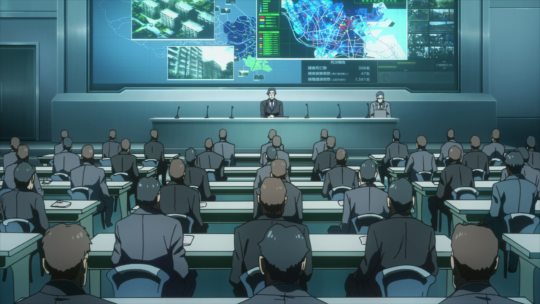
There isn’t really a ‘masquerade’ as such; ghouls are discussed on TV, and none of the protagonists are unaware of what a ghoul is. However, they do generally hide the fact they are a ghoul from their human friends and society at large, and many of the conflicts come from the possibility that a ghoul character’s friends or partners might discover their terrible, terrible secret.
Of course, it’s a struggle to have a sympathetic protagonist who’s compelled to subsist on cannibalism, so after a first few episodes where the protagonist Kaneki freaks out about having ghoul organs implanted into his body (like, seriously, that’s the premise lol) and almost eats his boyfriend totally heterosexual childhood best friend who he cares about above everyone else, he settles in with an organisation called ‘Antique’.
(Brief note about translation… at least in the netflix translation, it’s written あんていく, and it could be the te-form of ‘to knit’! but it’s probably ‘antique’, though why it’s written in hiragana not katakana I don’t know!)
Antique are like, the good ghouls who don’t murder people, but only eat people who’ve committed suicide.

Yes. This is a pretty edgy show.
The rest of the season plays out in about three arcs. In the first arc, an evil gay ghoul called the Gourmet wants to eat Kaneki because he’s a special one-eyed half ghoul (more powerful than normal ghouls! lollll), which is presented as basically being a sex thing. In the second arc, two members of the CCG kill a ghoul who’s presented as the Perfect Innocent Anime Mum in front of her daughter, and this leads to a cycle of revenge. Then, a bunch of extra bad, organised ghouls show up from another ward, led by series villain Jason, and kidnap Kaneki and torture him for… some reason. The CCG goes and storms their compound, while Antique try to rescue Kaneki.

The final episode mostly takes place in Kaneki’s head (c.f. NGE) where he gets lambasted by the ghoul whose organs were implanted in him (I still can’t get over that), and ends with him accepting his ghoul side, getting superpowered, and eating his torturer. At that point… it just stops abruptly. We don’t even see Kaneki meet back up with the rest of Antique. (I guess that’s all for the next season, but I’m going to write this post now while it’s fresh in my head)
In terms of the level of violence, I’m reminded of Baccano!, though really you could pick just about any somewhat edgy seinen. (Speaking of which, what’s with Baccano!? Once you manage to tease apart its nonlinear presentation, the primary story entirely amounts to ‘a bunch of immortal people who like murder get on a train and murder each other’!)
So what’s it saying with all this?
That’s the question right? Yeah there’s a bunch of people killing each other, what’s it all for?
To my mind the two most interesting bits of the story are the second arc, which is what made me inclined to compare it to NieR (mostly thinking ‘this is trying to do what NieR did but not as good’), and the protagonist’s inner monologue in the final episode of the first season.
I’m pretty interested in the problem of trying to tell a story about a conflict that points to a potential end to the conflict that isn’t the annihilation of one side or the other. Given that one side is literally flesh-eating ghouls, the anime goes to surprising lengths to parallel the feelings and efforts of the CCG ‘doves’ and the ghouls, emphasising both the sadism of some of the doves but also their interrelationships and grief when one of them dies - and likewise presenting the ghouls as sympathetic characters, even the ones who do murder and eat people.
There’s a sequence in the eight episode which intercuts dialogue from the two factions. First, Amon Kōtarō stands over Kaneki:



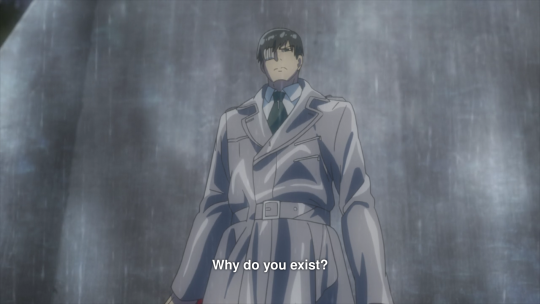
Rapidly, we cut to a parallel lecture from Kaneki’s friend from Antique, Kirishima Tōka, who’s standing over Amon’s partner Mado Kureo:
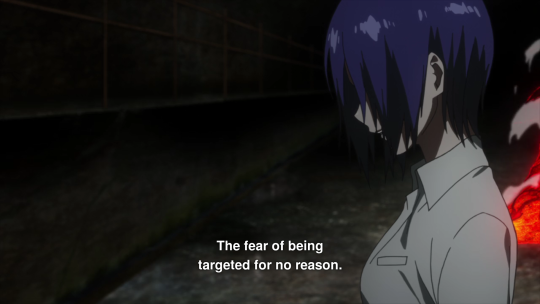
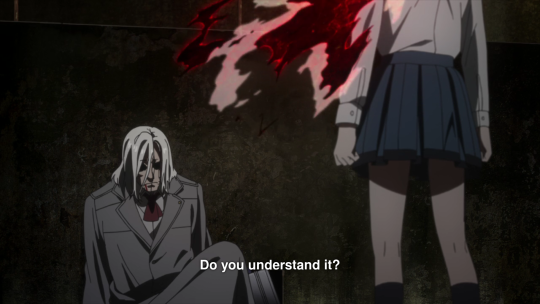
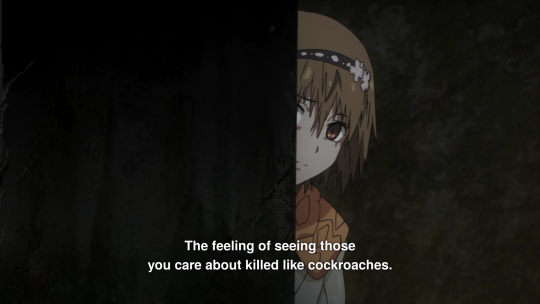

And so on. It comes to a head with almost directly parallel wording, rapidly cutting between characters:


Kirishima:

Amon:


Kirishima:

It could hardly be more explicit here: the Ghouls and the CCG are basically the same, but neither can see it. The thrust of this episode is Kaneki trying to get across to Amon that ghouls are people etc. etc., while Kirishima ultimately kills Mado; after the fact, we get various flashbacks aiming to develop Mado as something other than a sadist.
Like NieR and Mononoke-hime, it’s aiming to present a conflict where both sides are driven by grief and revenge, and both are suffering for it, even if one side ultimately instigated the conflict.

In the original NieR, the plot depends in part on Nier not being able to understand what the Shades (relapsed Gestalts) are saying; in the second playthrough, we are allowed to hear the Shades begging for mercy, and ultimately we learn that the protagonists are ‘Replicants’ who were supposed to be empty vessels for temporarily displaced souls, but somehow accidentally gained sentience.
The struggle is between two different versions of the same people, and it’s a situation set up that can’t not have a tragic ending; at best, Nier and his daughter/sister (depending on version) will be permanently separated while the Replicants keep dying to the Black Scrawl and the Replicants relapse; at worst, either the Gestalts or the Replicants must die, and since the Replicants can’t reproduce, the ultimate ending leaves humanity doomed to die out in a generation.
In NieR: Automata, we kind of know from the beginning not to take the things 9S and 2B say about the machine lifeforms at face value; and sure enough, the machines turn out to be just as capable of complex emotion and thought as the android protagonists. Both sides are chasing after their image of humanity. The war between was built on a false premise from the start and is sustained by various lies, in part because, for the leadership of both factions, ending the war is an existential (or perhaps existentialist!) threat.
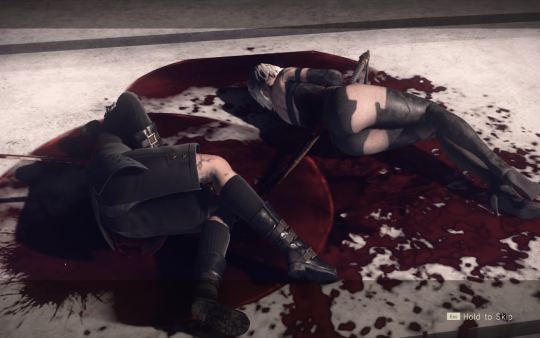
Like many of Yoko Taro’s games, NieR Automata takes place in a world that is overwhelmingly bleak. The game’s opening lines set the tone:
Everything that lives is designed to end. We are perpetually trapped in a never-ending spiral of life and death. Is this a curse? Or some kind of punishment? I often think of the god who blessed us with this cryptic puzzle, and wonder if I ever have the chance to kill him.
But unlike the original NieR, Automata points to a way to transcend its tragic ending, and crucially, refuse the unwinnable scenario imposed on the characters; textually, by the original no. 9 who created Project YoRHa and programmed the backdoor the machines use to destroy it, and metatextually, by the developers whose names you can only fight your way through by finding solidarity with others and explicitly disavowing the tragic, nihilistic conclusion. The pods, who gain sapience over the course of the game, offer an interpretation: we are perpetually trapped in a never-ending spiral of life and death - but life is ‘all about the struggle within this cycle’. For a Yoko Taro game, that counts as upbeat.
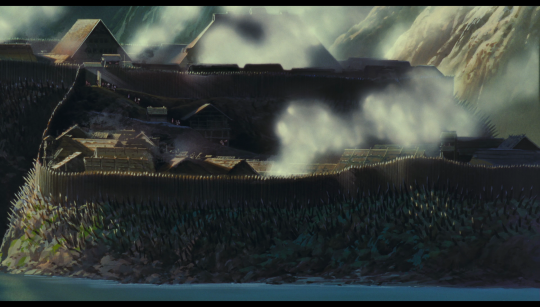
In Princess Mononoke, Ashitaka arrives on a conflict between the people of Irontown, led by Lady Eboshi, and the animal spirits of the Forest. Eboshi created Irontown as a sanctuary for certain groups of people marginalised from the larger feudal society, notably including sex workers and lepers. Under her, and with support from the Emperor, they created a colonial project in which they are mining iron sands under the forest, and using it to build weapons which they use to maintain independence against samurai who want to seize the ironworks. As much as Lady Eboshi could justly be accused of exploiting her subjects, it’s clear that the life they’ve created under her is a welcome alternative to the misery they endure elsewhere. But it comes at the direct expense of the Forest, whose animals throw themselves into futile resistance against Eboshi’s guns and bombs, only to be slaughtered en masse.
It comes to a head (lol) when Eboshi - on behalf of her sponsor, the Emperor, who seeks immortality, acting through his agent Jigo and his soldiers - tracks down and kills the Deer God, who’s central to the reproduction of the whole forest. This is simultaneously badass (“this is how you kill a god” sends chills) and obviously tragic; not only is she committing her worst violation of the forest yet, Eboshi has abandoned Irontown, under seige by the samurai, to pursue the Deer God. And while previously killing gods - specifically, boar gods - has caused them to become rampaging demons driven by revenge, killing the Deer God causes it to become a huge goo monster and engulf the landscape; the carnage only ends when Ashitaka and San intervene to return the head by ‘human hands’.
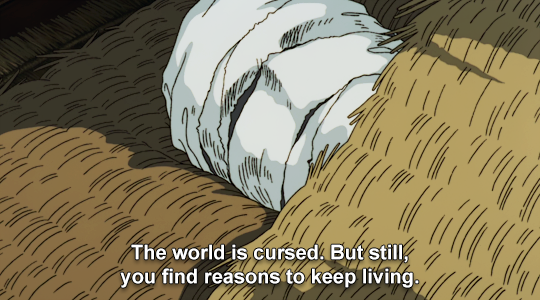
In this case, for the most part specific attention is not drawn to the horror of the situation itself, except in one memorable line shown above: “the world is cursed. But still, you find reasons to keep living.” This line is spoken by one of the leprosy patients in Eboshi’s gun workshop, and the speaker is on the edge of death.
The world of Princess Mononoke is one caught in an enormous transformation, one we can identify with the ‘primitive accumulation’ on which present capitalist expansion was founded; industrialisation is taking place, the feudal order is giving way, and guns—presented with terrifying destructive power, reducing a group of samurai to dismembered, screaming people, able to kill the gods themselves—have entered the world.
As much as he may deserve it, it’s not simply that these stories kill God. Killing God is a common enough theme in JRPGs—there’s a joke that goes the final boss of every JPRG is God, your dad, or both—but in NieR Automata the gods are all but absent (you wouldn’t even know there even are omnicidal gods unless you’re familiar with the broader franchise, specifically DoD and Grimoire NieR) and represented metaphorically; it is not 2B who kills God, but the player, shooting their way through the names of the developers who are, of course, the architects of the characters’ suffering.
On the other hand, in Princess Mononoke, killing (a) god is almost always a bad idea. The only hope for Irontown is if it breaks off its deicide habit and learns to find a peaceful accord with the (decimated) Forest. Since Ashitaka settles in Irontown, and San makes peace with him, we might think there is hope—how it will actually be able to do this, and overcome the material limits set by the broader context, is not spelled out.
We get it, you like NieR - where are you going with this?
I like these kinds of stories—ones which do not focus on ‘how the villain is defeated’ but ‘how the tragedy came about’ and in particular, if it can end in anything other than misery and tragedy. So how does Tokyo Ghoul compare?
I was inspired to draw these connections in part by a moment in the finale, where Kaneki has spent more or less the entire episode being physically tortured by Jason and inside his head, being lambasted by Rize (the ghoul whose organs were implanted into him) and told it’s all his fault. Eventually he resolves to change and fight back, with the words…
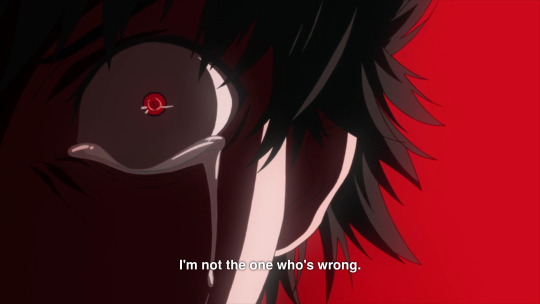

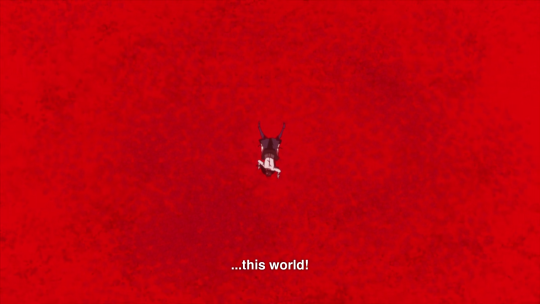
And that in isolation is a sentiment I can get behind. But how does he come by this?
The final episode is for the most part a repudiation of Jesus. No, come back! I’m being facetious. But…
Kaneki relates how he gets his meek attitude from his mother, who he describes as having lived by a philosophy of…
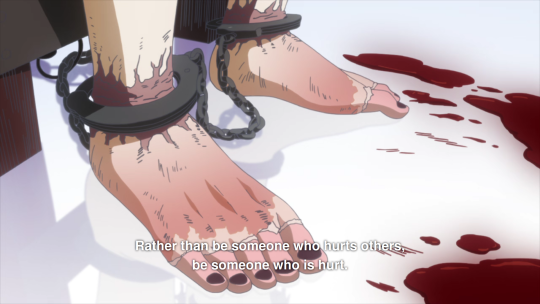
“Rather than be someone who hurts others, be someone who is hurt.” This philosophy, we learn, caused Kaneki’s mother to literally work herself to death supporting her sister; Rize pushes Kaneki to acknowledge that he resents this, and can’t accept his mother was in the right. (The mother and sister do not get names.) Rize pushes Kaneki to instead take responsibility for everything that has happened to him, echoing the villain Jason: “all disadvantages exist due to a lack of skill of the man involved” - straight up, the capitalist fantasy of meritocracy.
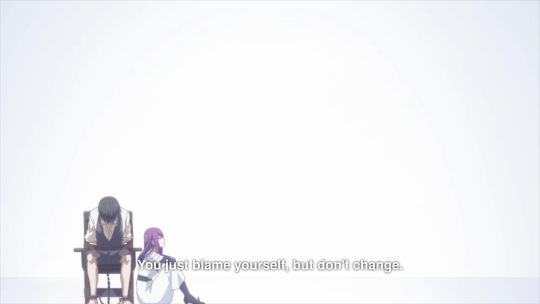
Somehow seemingly discerning what thoughts Kaneki is dealing with (I guess torture is second only to the Human Instrumentality Project for encouraging introspection!), Jason forces him to make a choice between two peoples’ lives - and when Kaneki won’t choose, kills them both. Contrived, right? I think they put that one in a videogame. A lot of videogames.
The point is that Kaneki needs to get stronk and murder Jason, instead of being a total doormat who does lame uncool things like get tortured. But to get there, Kaneki has to face up to the whole ghoul thing…
Rize tells him that his philosophy means he fails on both counts, that his efforts to hurt nobody cause him to hurt people more than if he made a choice…
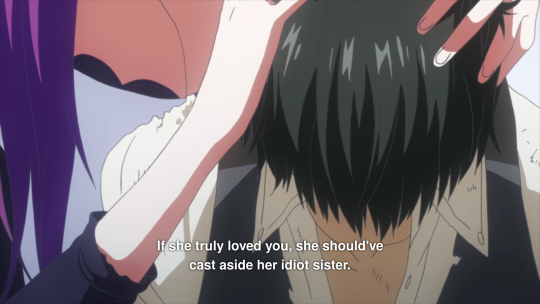
There’s a couple of ways to parse this. One has like, eugenics undertones. But there is a sense that like… none of us have the capacity to do everything. As the song at the end of NieR Automata goes, at least in the English version…
I wish that someway, somehow
That I could save every one of us
But the truth is that I’m only one girl
And that miserable limit is worth facing up to, and respecting. But that isn’t really what Rize has in mind. She justifies eating people by getting Kaneki to tell her that he wanted his mother to live for him, even if it came at the expense of his aunt’s life…
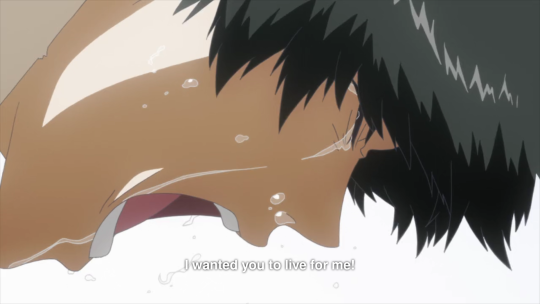
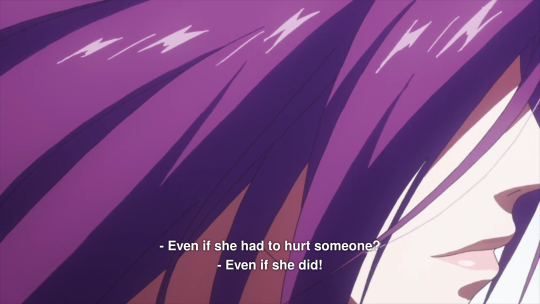
Rize makes it clear: you gotta treat people as disposable. You gotta.
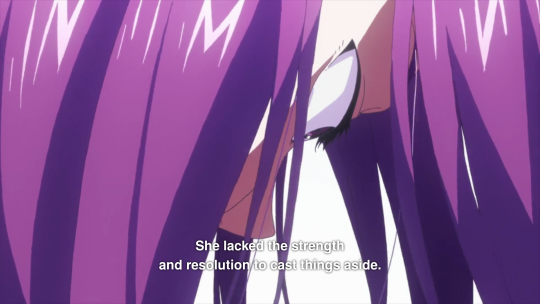
Finally persuaded, Kaneki says those lines above about ‘this world’ being what’s wrong, and leaps on her and eats her, in a pose that’s extremely sexualised…
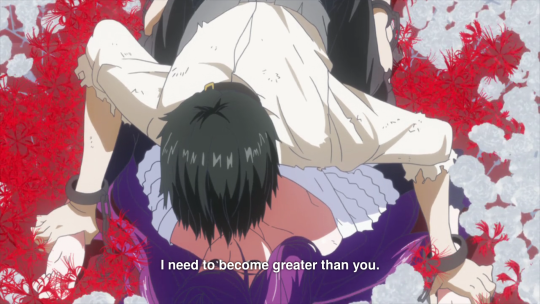
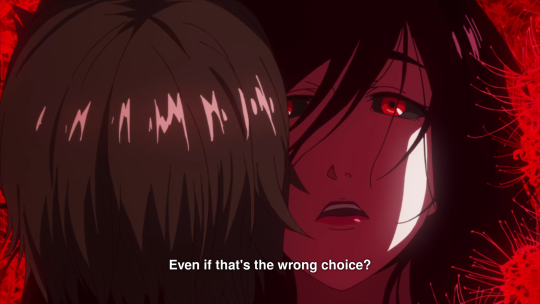
Rize encourages this. And she says something interesting as her final words…
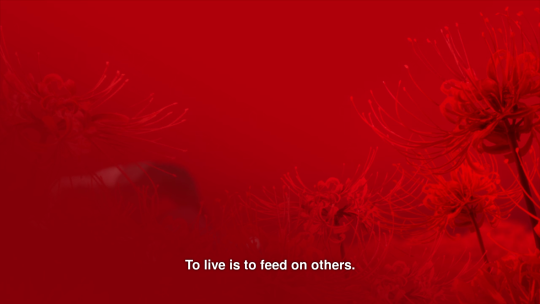
“To live is to feed on others.” (That’s Kaneki eating her in the background there.)
So…
what to make of this scene? After this, the theme music kicks in mid-episode for the first time, Kaneki gets an appearance transformation (white hair etc.), crushes Jason, briefly forces him to undergo a similar torture, and then eats him (getting more powerful in the process).
“To live is to feed on others.” This is what Kaneki accepts, as the alternative to being a total doormat. Well, so far, kinda fash. What I wanted to say about this is that… in these words, Rize has captured what’s wrong with “this world”. Because in this particular regard… she’s not wrong.
(I actually saw a plot summary on Wikipedia and it seems that this ideology does not take Kaneki anywhere good, and he eventually renounces it and gets brain damage or something?)
Consumption
Let’s abruptly switch tracks to a Daniel Kahn song! (I promise it’s relevant. Ish.)
“It’s just a little song about our needs.” says Kahn, as he tells us about the “horror story” in the price of every commodity: “a story about factories and fields, a story of the power people wield”. Quotes from Capital scroll rapidly past.
To live is to feed on others; this is the world of capitalism. But it’s not only the world of capitalism. It’s also the logic of the evolution of nearly every organism - even the photosynthesisers need chemical constiuents; plants grow from a soil of decaying matter.
What is money but a highly abstracted way to force people to give up the hours of their life? For all of us, not just the capitalists, although the capitalists are the primary actors there.
Because in this world of ‘generalised commodity exchange’, we cannot live except by buying our means of subsistence (food, warmth, etc.), which means we need money and so does everyone else. And to get those things… we say ‘I will give you money, and a fraction of the ability to live another day, if and only if you do this for me’.
“You’d like to make believe that you receive what’s only fair, that no-one has to suffer to keep you in your chair, but you’ve gotta give the butcher his share…”
This is the antagonism between producers and consumers, the one that’s hard to say we might abolish as ‘easily’ as the antagonism between different capitals. Work less, and yet have more…
But that probably just seems like philosophically jujitsuing myself into a hole. More concretely, then… under conditions of capitalism, where we each have no choice but to participate in a vast circulation of commodities that ultimately functions towards the end of accumulation of vast concentrations of wealth, whose logic demands we each become more miserable as the margins get ever thinner; especially, those of us in the ‘metropole’, where those vast stocks of commodities pile up far more than we actually have a hope of using and we are told of the immiseration of those who produce them but afforded few means to do anything about it…
Well, ha, perhaps a flesh-eating ghoul, who has no choice but to eat people to stay alive, is not such an useless metaphor.
(How far are the flows of capital different from the flows of energy or carbon through the food webs? Are we damned from the start, by the logic of evolution and the constant drain of entropy into space?)
So returning to the earlier thread… if ‘this world’ that’s so broken is the one where ‘to live is to feed on others’, where the logic Rize offers of selfishness out of presumed necessity is the hard-to-escape conclusion - what would it mean to transcend it? What is the alternative?
Of course, the alternative to consumption is that which isn’t destructive - sharing, participating in things which fulfill our needs without feeling like something has been taken from any party. Building something together and sharing in the result. This is all but impossible to imagine under present conditions, where just about every activity one can do involves buying something, participating in the consumption of someone’s life… ‘production creates the consumer’, as Kahn says.
Or maybe this metaphor is stupid, and the only thing that’s being devoured here is your time…
Postscript
Now don’t get me started on the goddamn queercoding. I haven’t even talked about that one ghoul who shows up in the last few episodes who’s like a super effeminate masochistic gay guy on the baddies side. And I won’t.
Comments